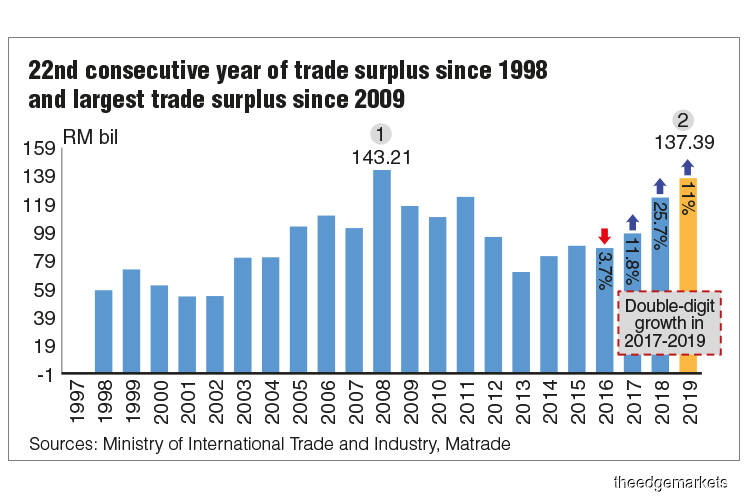Wider trade surplus a sign of weakening economy?

KUALA LUMPUR: Malaysia’s trade surplus ballooned to RM137.39 billion last year, up 11% from RM123.78 billion in 2018. It is the largest trade surplus since 2009.
Nevertheless, there might not be a good reason to cheer about.
While a wider trade surplus is usually viewed as positive, Socio-Economic Research Centre executive director Lee Heng Guie, however, pointed out that last year’s overall trade figures that are weighed by lower total imports could be a reflection of a weakening economy.
“Overall, we still have a trade surplus, which is good, but if the trade surplus is coming from a sharp import compression then it doesn’t look good,” said Lee.
Malaysia’s annual imports shrank by 3.5% to RM849.01 billion compared with a 4.9% growth to RM877.74 billion in 2018.
One of the three main components, namely intermediate goods which account for 55% of total imports, only saw a 1.1% increase.
“This is not very healthy,” Lee told The Edge Financial Daily, adding that this could imply that the Industrial Production Index may not be strong in the next few months.
RHB Research Institute chief Asean economist Peck Boon Soon, on the other hand, said the more subdued import growth was due to a sharper contraction in capital goods imports.
Capital goods, which make up 11.8% of total imports, fell 10.8% due to lower imports of transport equipment for industrial, particularly aircraft.
“This may not be good for the country’s future economic growth as it implied businesses are pulling back investment,” said Peck.
Over time, Peck believes the huge surplus will shrink when we start to import more again when economic activity picks up.
Meanwhile, Sunway University Business School economics Professor Dr Yeah Kim Leng explained that Malaysia’s exports have high import contents, given that Malaysia is a key participant of the global value chain.
Thus, lower exports will translate into lower imports of intermediate goods and services, thereby assuring a trade surplus.
He, however, highlighted that if domestic demand, especially investment, is strong, the surge in capital and consumption goods imports could result in a temporary trade deficit or a deficit in the current account that includes services trade.
“It is positive in that the economy is not facing a destabilising twin-deficit situation. A current account deficit would mean that the country’s savings are not enough to finance investment needs, making it dependent on foreign savings,” said Yeah.
He added that if imports continue to decline due to falling exports then it is adjusting naturally as there is less need for imported intermediate goods.
In contrast, if falling imports are due to weak domestic demand, particularly investment that needs imported capital goods, then the country’s medium- to long-term growth faces diminishing prospects.
‘Growth in exports in 2020 intact’
Economists are anticipating growth in annual exports in 2020 following a 1.7% decline in Malaysia’s total exports last year despite the uncertainty arising from the Wuhan virus outbreak.
UOB Malaysia senior economist Julia Goh and economist Loke Siew Ting wrote in a note yesterday the research outfit remains cautious and maintains its 2020 full-year export growth forecast at 2% for now.
“There were some early signs of recovery for Malaysia’s exports prior to the coronavirus outbreak,” said UOB Malaysia, noting that there are uncertainties over the impact of the outbreak on manufacturing supply chains in the region.
Malaysia’s import dependence on China is relatively high for manufactured goods and transport equipment, according to UOB Malaysia.
It highlighted that there are risks that the Wuhan virus outbreak may derail China’s ability to fulfil the phase one of US trade deal which is supposed to take effect in mid-February, while a global technology downcycle could drag beyond mid-2020.
Sunway’s Yeah commented that should the pandemic be contained in the first quarter, the better economic growth and trade performance anticipated for this year can still be achieved.
“Otherwise, the subpar performance will continue this year with negative output and trade gaps depending on the severity and duration of the pandemic,” he added.
RHB highlighted that it may appear that trade could have reached the bottom and is ready for a rebound.
“The support not only comes from better palm oil prices in recent months but also underlying demand from non-electronics and electrical and non-commodity products,” he wrote, adding that recent growth in Purchasing Managers’ Index data seems to support this notion as well.
Looking ahead, RHB forecasts that export growth will remain around 1.5% in 2020, with possible upside revision if the pattern of recovery continues.
( 24,36 % )
( 39,38 % )
( 36,26 % )


